






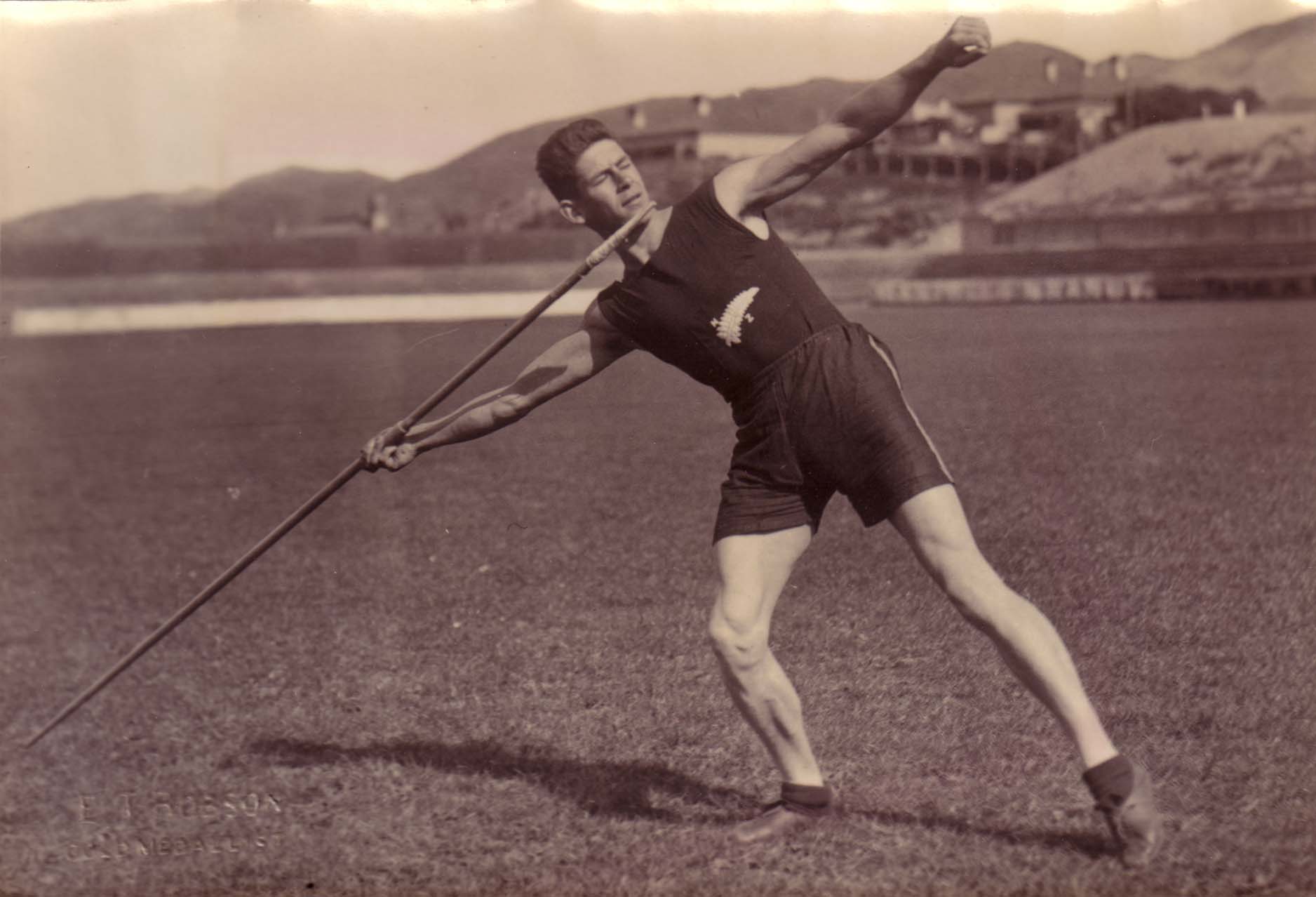
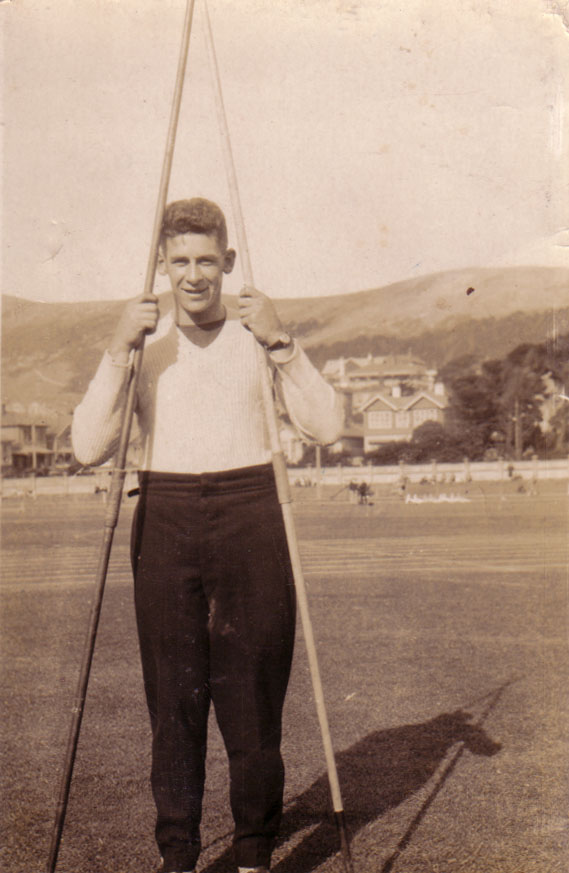
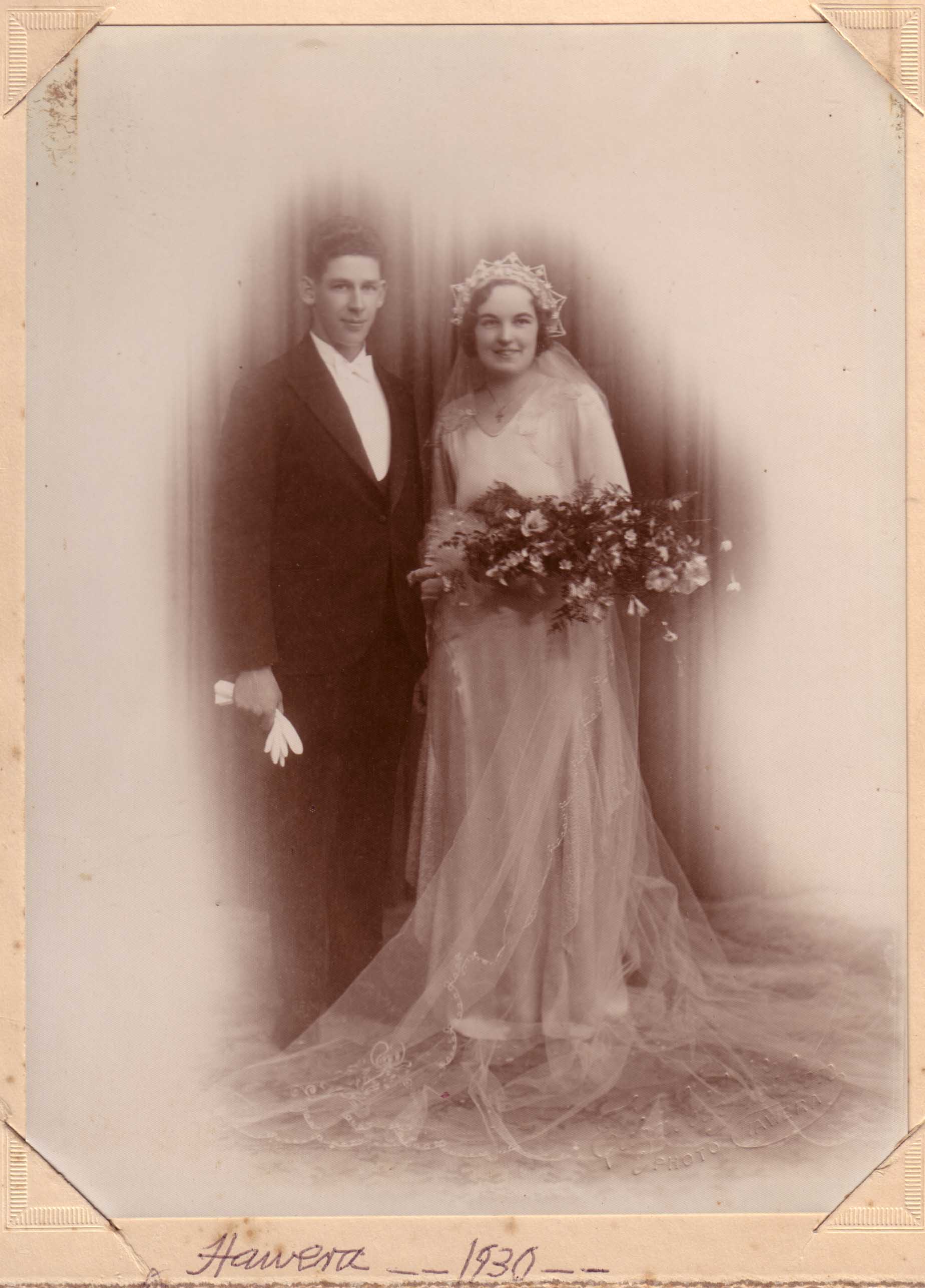
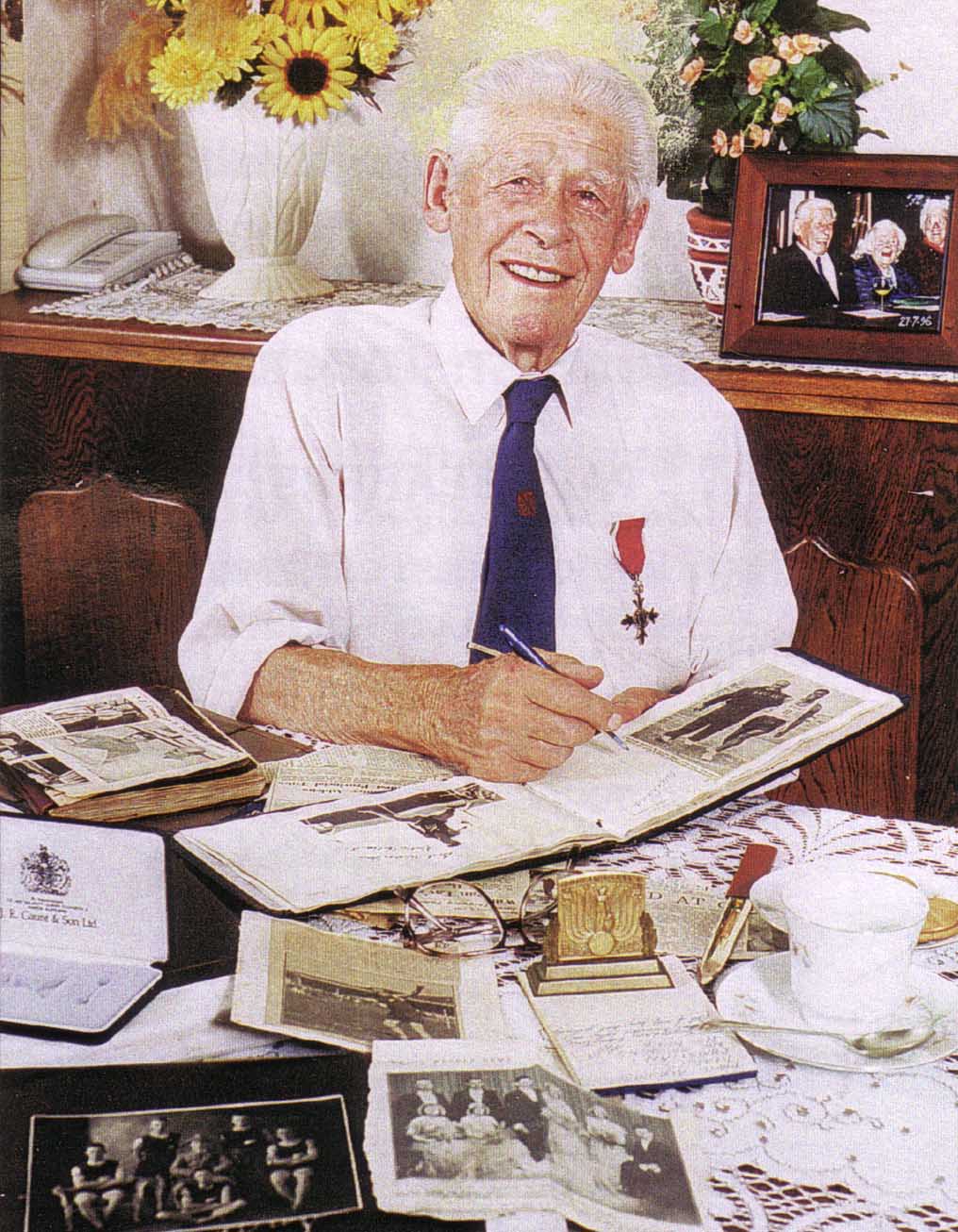
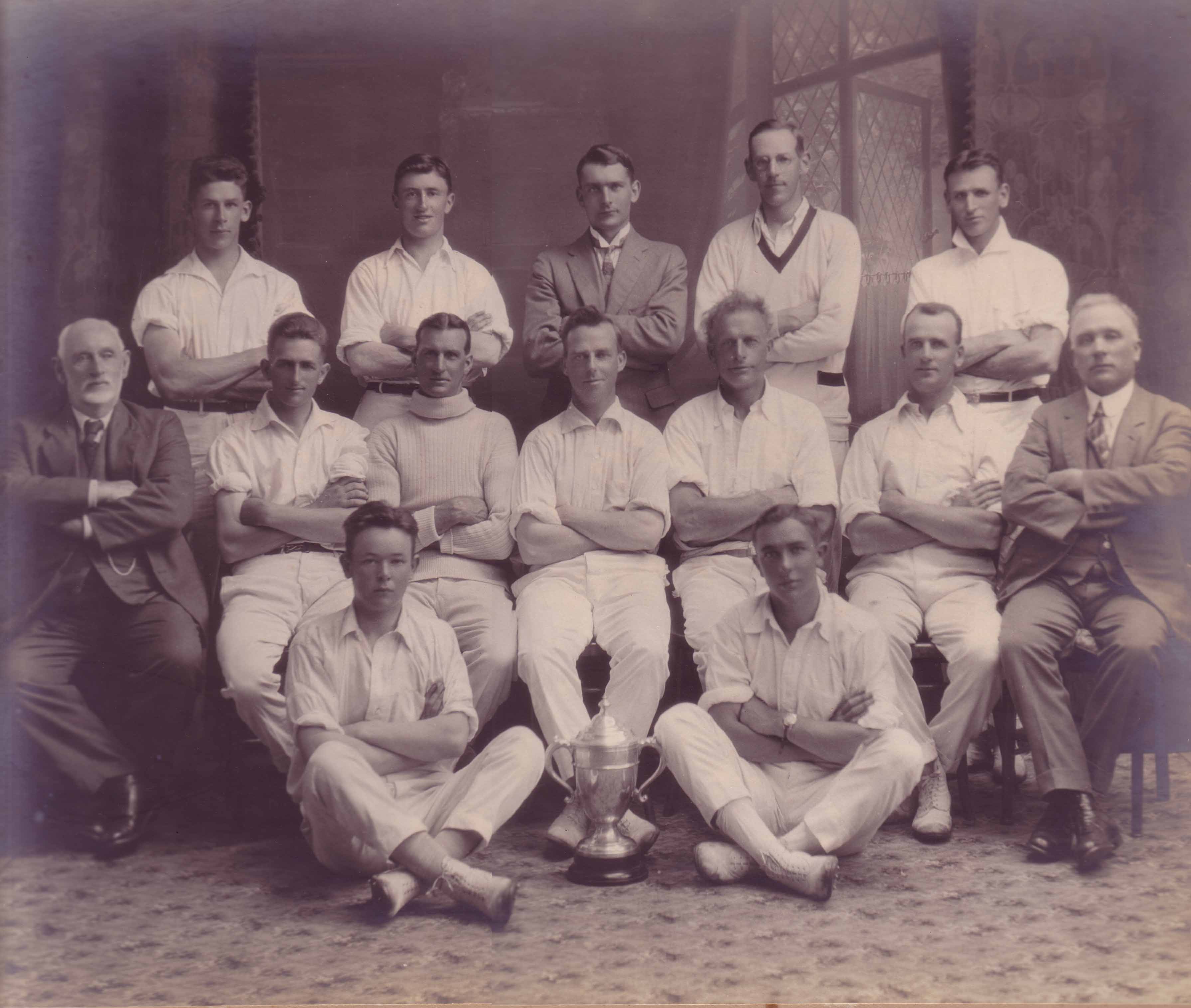
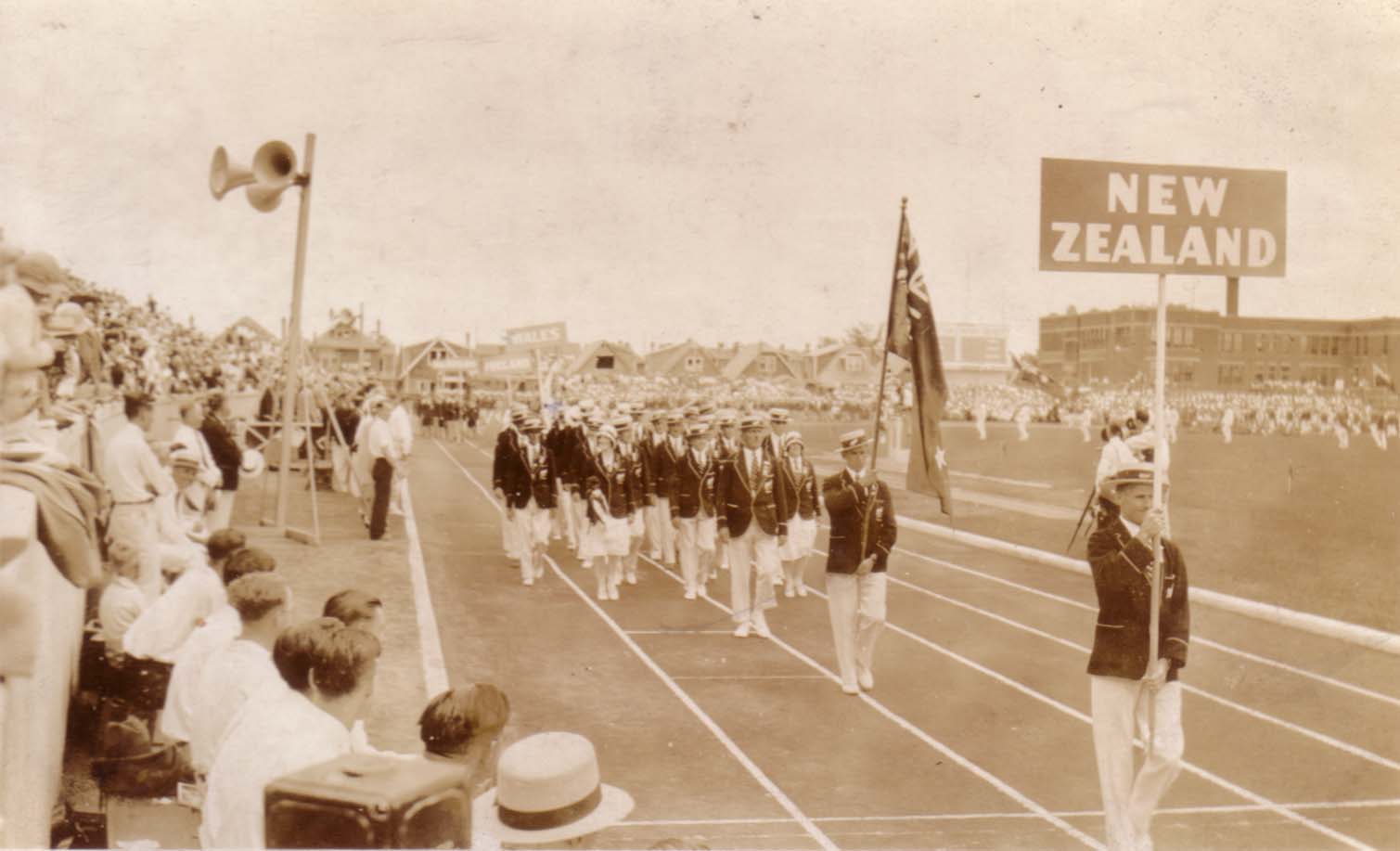
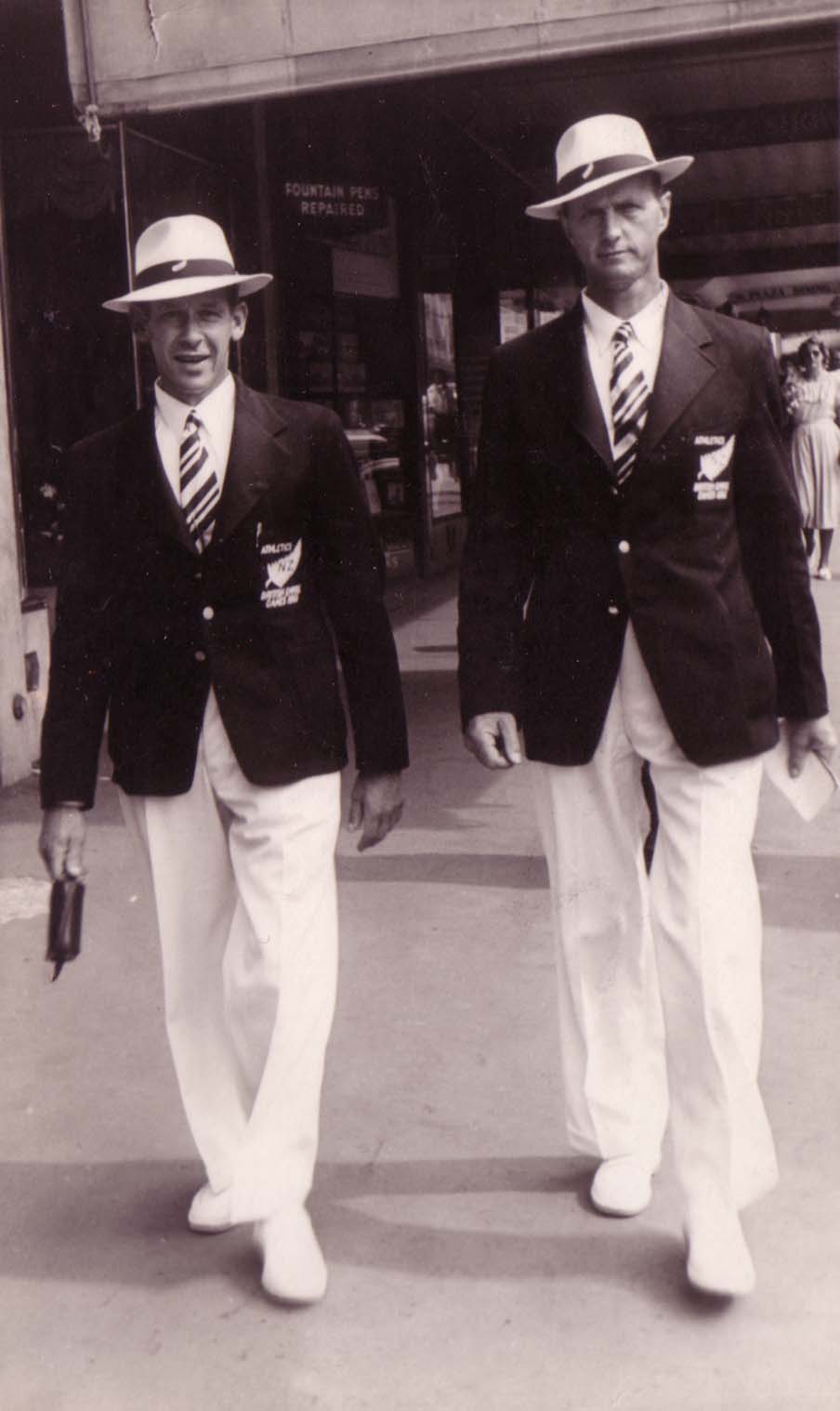
With arms like an albatross, Olympian Stan Lay was born to fling a javelin. "He was short with this terrific arm span that made him a natural for throwing" says son Peter Lay, a retired doctor. The average span of a man's outstretched arms is equal to his height. But Stan was no ordinary man. He was 1.75 metres tall, while his arms, from fingertip to fingertip, measured 1.93 metres.
Along with his long limbs came an uncanny sporting ability. He played tennis, cricket, soccer and rugby, while at athletics meets he would compete in hurdles, running events, long jump, high jump and javelin. But he was a specialist thrower, a talent that earned him an Empire Games gold medal, Olympic selection and an unclaimed world record.
Stan's story begins in New Plymouth on July 27, 1906. That's the day he was born to English immigrants Minnie Rebecca (nee Coulam) and Arthur Harry Lay. There were five children in the Lay family - Mona, Stan, Tom, Gladys and Malcolm.
While his life began in New Plymouth, his fame - and javelin throwing - started in Hāwera. After a short spell doing odd jobs in New Plymouth, Stan's father landed a plum job in south Taranaki. From 1910 to 1930, Arthur was curator of King Edward Park in Hāwera and the family lived on the spot.
"My first sport contacts were all at King Edward Park" says Stan, in an oral history recording from 1993. "All sporting things were held in or near the park… All very close, so of course we got into sport because it was in our backyard." The sports-mad youngster was a handy rugby first-five-eighth, but it was cricket that launched his throwing career.
"He could toss a cricket ball across the field, whereas most of us could only get half way" says son Peter. Peter says his dad could also throw with run-'em-out accuracy - as Wellington cricketer C.S. Dempster found out in 1926. The capital batsman whacked a ball towards the boundary and was ambling for a third run when Stan swooped. The Taranaki all-rounder scooped up the ball and fired it home. Dempster was nowhere near his crease when the wickets exploded as if hit by a grenade. Peter says some wicketkeepers, while happy to have such a crack-shot in the field, didn't enjoy the sting of catching a Stan-slammed ball.
The force brought him to the notice of Hāwera man Len Hunt, captain of the town's amateur athletic club. "He got me and said 'I think you would be good at javelin-throwing Stan'. I said 'Well, where do we try it out?'"
On a Sunday morning at the A&P Showground, Stan had his first try. "I was 17 then, when I started javelin throwing. It wasn't long before I started to progress." He became the best in Hāwera, then the Taranaki champion, then took the West Coast (of the North Island) title. "I competed in the New Zealand Champs in Wanganui in 1925, just as a local boy."
Stan says his rivals were big men, mostly policemen, who also threw the shotput, hammer and discus. "There were no real specialist javelin throwers." That first year at the nationals, Stan was fourth. "I threw 140-something feet [around 42 metres] and the winners were about 155 feet [47.24 metres]."
But Stan began to practise, perfecting his technique until he could make the javelin soar. The following season, the Hāwera sign writer finally made his mark at the New Zealand championships in Otago. "…I had improved quite a bit and I finished down in Dunedin winning quite convincingly with 182 feet [55.47 metres] and the other throwers were all around the 150-60 [45-48-metre mark]… I was on the up then…"
In 1926, Stan made the New Zealand team and had his first overseas trip. "That was on the boat from Wellington - three-and-a-half days getting to Sydney" he says. "Then from Sydney up to Brisbane on the train - quite a long journey."
At the Australasian championships, Stan won the javelin title, a feat he repeated the next year in Wellington. At that Boxing Day meet, he became the first Kiwi to throw the javelin more than 60 metres.
His throw of 218 feet 2.75 inches (66.51 metres) was a little more than world mark, but it didn't get him into the record books. "In those days if you were throwing with a following wind, they wouldn't grant you a record, because it was wind-assisted, which was common-sense in a way" he says.
In 1928, he was named in the New Zealand team to compete in the Olympic Games at Amsterdam. To get there, the Kiwis had to spend four weeks on a ship. First stop was Great Britain. "We went fairly early to England so the runners could get the practice in after a long sea voyage, because you lose form…" Stan trained at sea by throwing potatoes off the deck into the ocean.
In England, he competed in a London meet at Stamford Bridge. He only managed a throw of 200 feet 1.5 inches (61 metres), but his natural talent caught the eye of famed athletic authority Captain F.A.M. Webster.
During the week leading up to the British championships, Webster coached the Taranaki sportsman in his throwing technique. He told the Kiwi that a javelin was meant to be thrown like a dart, with the thrower required to ‘palm it up’ during the final thrust. Stan tried the new style while Webster snapped photos, which the men later studied.
On Saturday July 7, 1928, the New Zealander again stepped out at Stamford Bridge dressed all in black, a silver fern on his singlet. The javelin arena was marked out and competitors were silently urged on by two small flags - the Union Jack marking the British record at 212 feet (64.61 metres), and a dark blue one indicating the world record at 218 feet (66.44 metres).
With his second throw, Stan's javelin passed the Union Jack. But it was his sixth and final throw that caused the London crowd to gasp.
In his book, Lap of Honour, sportswriter Norman Harris describes what happened: “As Lay walked easily back to his mark he could be seen to place his hand over his heart. His heart? No, what he felt for was the little smooth object sewn at the back of his silver fern, a greenstone tiki presented by the Maori people of Hawera. It was there."
With the concentration of a fighter pilot, Stan shot the javelin into the sky. The spear flew, like an arrow from a warrior's bow, tracing an invisible arc over the sports ground. "The javelin falling now" Harris writes, "but passing over the Union Jack, then over the marker for Lay's second throw, then dipping down for the dark blue flag. A loud shout from each of the 300 people as the javelin head struck, stuck, and stood quivering four feet past [1.21 metres] the dark blue flag."
Stan's throw was 222 feet 9 inches (67.89 metres). "I won the javelin…with the best throw I ever did" he says on the tape. "Big headlines because I had unofficially broken the world record at that time." But again, Stan's throw never made the world record book. The reason this time wasn't wind, but a Finn.
The previous October, Eino Pentilla had thrown more than 229 feet (69.79 metres) and his distance was ratified by the time the English officials put Stan's distance forward. However, the Hāwera man's big throw was a British record. It stood for another 29 years, finally being bettered in 1957.
Stan didn't continue his top form at the Amsterdam Olympics. "Everyone had three throws and then they picked the best six out of all the 35 throwers and I was seventh at that stage, so I didn't get any more throws" he says. "It was only after the Games were over that they realised that was the wrong thing to have done and later on, for the next Games, they had a qualifying distance."
On top of the disappointment, Stan had made great financial sacrifices to attend the Olympics. "During that trip overseas I was away for five and a half months with no pay coming in anywhere" he says. "It was still a good experience; a great holiday in a way."
The lack of money didn't put Stan off travelling abroad to represent his country. In 1930, he was chosen for the inaugural British Empire Games, to be held in Hamilton, Ontario, Canada.
Once again the Kiwis travelled by ship, this time with the Australian team. "We were cobbery with the Aussies right through," he says. "It was nice that way and training on the deck as best we could and then on to Vancouver. [We] stopped one night and [went] through the Rocky Mountains on the Canadian-Pacific Railway, which was a lovely experience…"
In Hamilton, Stan was on form. His throw of 207 feet 1.5 inches (63.13 metres) won him the gold medal. It was another 24 years before that Empire/Commonwealth Games mark was bettered.
Back home in Hāwera, he made other improvements, this time to his life. On 12 August 1931, he married Ngaio Kirwin. The following year, the newlyweds had their first child. "I was born two days before they were married" says Peter, a twinkle in his eye. "In 1932."
Because of his new family, Stan made himself unavailable for national selection. But when the Empire Games were planned for just across the ditch in 1938, he reckoned he could spare the time. By then, Stan and his family had moved to Stratford.
The move to Stratford was a matter of loyalty to Stan Reece. After leaving school at the age of 14, Stan Lay began his sign-writing apprenticeship with the elder man. Once of his first jobs was to paint car number-plates, which were all hand-done in those days. After ten years, Stan the younger wanted his own business, so moved towns. "I didn't want to start work in opposition to my old boss - I wouldn't do that."
Peter remembers his dad training at Victoria Park in Stratford with the Radich brothers, Ned and Joe. His coach on New Zealand soil was a man called Karl Dahl. "The javelins in his day were just solid chunks of wood and he used to practise with bamboo" Peter says,
Stan made certain he didn't over-do it on training days. "The secret of javelin throwing is not to do too much throwing in training" he told the Weekly News in 1967. "I believe in storing up energy in the arm so that it is there for an explosive effort when required for important competition." Fitness was gained on the go. "I don't ever remember seeing him exercise as such. Just riding his bike kept him fit" Peter says.
Stan's children, Peter, Wendy, John and Greg, have everlasting images of seeing their dad head off to work.
"Every morning he would hop on his bike with a wooden box and at times he'd have a ladder on his shoulder" Peter says. Stan's daughter-in-law Margaret Lay continues the tale about the man they all called ‘Pop’. "He told us the story of how he biked from Stratford to Inglewood with a ladder on his shoulder. Pop always had a bike - he didn't have a motorcar until 1954. After that, when he did get a car, it had to be able to have a ladder on it."
So, the working-fit and far-throwing father was chosen for the 1938 Empire Games in Sydney. Again, the New Zealand team travelled by boat across the Tasman.
This time, the gold was won by Canadian Jim Courtright and Stan had to settle for the silver. But his throw of 204 feet 1.25 inches (62.21 metres) was good enough to beat the Australian wonder jumper and thrower, Jack Metcalfe, who took bronze.
From 1939-45, the world was at war, forcing the cancellation of international sports meets, including the Olympics and Empire Games. In the latter parts of World War Two, Stan was on Home Service for two-and-a-half years. "I was conscripted. I remember it was the saddest day of my whole life… going from New Plymouth down to Trentham Camp, leaving my wife and three kids at home" Stan says.
Appropriately, the Taranaki thrower was a physical training instructor at Wellington and then Blenheim. He was finally transferred to New Plymouth, where he moved his family in 1940.
After the war finished, Stan returned to national competition, winning the New Zealand javelin titles in 1945 and 1946. In 1948, he was beaten by Claude Clegg in Dunedin - Stan's only ever defeat by a Kiwi at the nationals.
Stan got the title back in 1950 and was named in the New Zealand team for his third Empire Games, this time held at Eden Park in Auckland. "I was well down on performance then. I was then 43 years old, you know, so I was getting a real oldie" Stan says. "That year I only got sixth in the distance, but I had the honour of taking the oath on behalf of all the athletes. Part of the opening ceremony is that one of the prominent athletes of the local country takes the oath of amateurism" he says on tape.
"This would have to be the highlight of my career. It was an honour representing all the athletes in proclaiming we would compete for our countries and the glory of the sport" Stan told the Taranaki Herald in 1988.
His family believe that it was fitting honour for Stan to take the oath. "He was the ultimate amateur" says Margaret. Peter says his dad could not understand why an athlete would take performance-enhancing drugs or accept money to compete. "It was beyond his ken."
After the Auckland-based Games, Stan retired from competition. "I started in 1925 at the New Zealand Champs and finished up in 1950… I had 25 years in the top stuff."
When Stan Lay's javelin drooped during the last decade of his life, his family called for fair play. Without the New Plymouth man's permission, a doctored picture of him holding a limp javelin was used in an advert offering assistance for men with impotence problems. There was a personal and public outcry at the gall of advertising company Colenso Communications for using the image. "We just assumed because the picture was so old that the person in it would have died by now" Colenso boss Adrian Hood told the national media.
Stan (then 90) was ticked off. "It's bit on the nose really, isn't it? It's a bit of a let-down." The insult cost the company $10,000. Being the true amateur, Stan donated the entire amount to Athletics New Zealand, of which he was patron. His accompanying letter contained wise, but firm advice about improving the sport and bringing the spectators back to the track.
Even though the Empire Games gold medallist retired from top competition in 1950, he stayed on track, repaying his success through coaching and officiating. His son, Peter, believes that sometimes his dad did too much. "There were times I got hacked off for mum's sake - he was always away coaching. He was never at home a lot of the time."
As well as athletics, Stan was a busy self-employed man with a second-storey office on Currie Street between a dentist and a billiard parlour. He also had a workshop under his lifted-up home on Leach Street, where he lived with Ngaio until she died in 1974. Later, he shared homes with his sister-in-law Phyllis, the wife of Stan's late brother Malcolm. The widowed pair found their platonic arrangement suited them both.
They kept each other company and Stan had someone to cook and clean for him. "He was a real old-timer" says daughter-in-law Margaret Lay. "Women had to know their place… In many ways he was a male chauvinist and he never changed. Women didn't go back to work [after marrying or having children]. He didn't believe women should be prime ministers." Peter agrees: "He was quite a character; very set in his ways. But you always knew where you stood with dad."
He was always there to help his four children and their families with gardening and decorating. "But he needed to be heavily supervised by the woman of the house, otherwise you may get what you didn't want" says Margaret. "He did like to do it his way, but he was wonderful at giving a hand." Stan also visited sick people in hospital and later rest-homes.
The Taranaki athlete was also a dedicated member of St Mary's Pro-Cathedral. He was a sidesman there for more than 40 years, welcoming people into the church. Outside, he was often seen working in the garden, sweeping leaves, and he was always on hand to fulfil any sign-writing needs.
In 1987, he became a Member of the British Empire (MBE) for his service to athletics and the community. Among those to testify that Stan deserved such recognition was Lord Arthur Porritt, manager of New Zealand's first Empire Games team. "In his active athletic days of the early 1930s, I knew him personally and well" writes Lord Porritt. "…he was a fine ambassador for New Zealand - unassuming, cheerful, always co-operative and a true sportsman in the best sense of that word…"
Stan, the man who carried the flag for New Zealand at the 1930 Empire Games, had a life-time love of the sporting event that became the Commonwealth Games. "I have been a great supporter of the Games as a spectator" he says, on an oral history recording. He joined together with the crowds at the Christchurch Commonwealth Games in 1974; went to the 1978 Edmonton Games in Canada; Brisbane in 1982; and when he went to the Edinburgh Games in 1986 he presented medals to the javelin place getters.
In 1990, Stan was inducted into the New Zealand Sports Hall of Fame. The then 84-year-old drove by himself from New Plymouth to Wellington for the ceremony. The determined and sometimes stubborn elderly man kept his licence until the age of 93. In fact, it was exactly those traits that made aim for the sky. "It was his determination and dedication to whatever he did" says Margaret, a retired teacher. "Once he had a goal, he focused."
He also held a torch for a long-time love. In 2000, Stan was made the spiritual guardian of the Olympic flame during its journey through New Zealand to the Games in Sydney, Australia.
At the end of 2002, Stan's inner flame began to ebb. "He basically just faded away" Peter says. "He was not well for five or six months." On May 12, 2003, he died. He was 96.
"When Pop died, so much stuff came out of the woodwork" says Margaret. "It became very apparent on his death that the family would have to take second place, because he was public property. I think one was a little surprised - because of his age. We were staggered from the letters and cards from all over New Zealand." Peter nods: "He touched a lot of lives, one way and another."
Taranaki Cricket Representative player from 1926-31.
Member of the Taranaki team that won the Hawke Cup in 1926.
Played for Taranaki against the 1928 Australian and 1930 MCC teams.
Won the Australasian javelin championship title in 1926 and 1927.
7th at the Olympic Games in Amsterdam in 1928 and the first New Zealand thrower to represent New Zealand at the Games.
Won the British javelin championship in London in 1928.
In 1930, he won a gold medal at the inaugural Empire Games in Hamilton, Ontario, Canada.
Took the silver medal at the 1938 Empire Games in Sydney, Australia.
Was 6th at the 1950 Empire Games in Auckland.
Stan Lay won the New Zealand javelin title on 12 occasions from 1926-50. These are the exact years and distances:
1) 1925-1926 with 182 feet (55.47 metres)
2) 1926-1927 with 194 feet 6.25 inches (59.29 metres)
3) 1927-1928 with 197 feet 8 inches (60.24 metres)
4) 1928-1929 with 206 feet 6 inches (62.94 metres)
5) 1929-1930 with 199 feet 9.5 inches (60.90 metres)
6) 1933-1934 with 192 feet 0.5 inches (58.53 metres)
7) 1934-1935 with 187 feet 1 inch (57.02 metres)
8) 1936-1937 with 195 feet (59.44 metres)
9) 1938-1939 with 197 feet 10 inches (60.30 metres)
10) 1944-1945 with 179 feet (54.56 metres)
11) 1945-1946 with 184 feet 4.25 inches (56.19 metres)
12) 1949-1950 with 166 feet 11 inches (50.88 metres)
On Boxing Day 1927, he became the first New Zealander to throw the javelin further than 60 metres. That throw of 218 feet 2.75 inches (66.51 metres) was just short of the world record. While it won him the Australasian title, it didn't earn him a record as it was deemed to be a wind-assisted throw.
In 1928, Stan set a British record in London, with a throw of 222 feet 9 inches (67.89 metres). That was a world record, but was already beaten by the time officials went to register it. That British record stood for 29 years.
In 1929 he set a New Zealand and resident record with a throw of 206 feet 6 inches (62.94 metres). That record stood for 27 years.
Stan's 1930 gold-medal-winning throw of 207 feet 1.5 inches (63.13 metres) set an Empire/Commonwealth Games record. That mark stood for 24 years.
Carried the New Zealand flag during the opening ceremony of the 1930 Empire Games in Canada.
At the opening ceremony of the 1950 Empire Games in Auckland, Stan took the Oath of Allegiance to amateur sport on behalf of all the competitors.
In 1978, Stan received a City of New Plymouth Citizens Award.
He was Taranaki Centre patron of the New Zealand Amateur Athletics Association (NZAAA).
Presented medals to the javelin place-getters at the 1986 Commonwealth Games at Edinburgh, Scotland.
He became a Member of the British Empire (MBE) in 1987.
Stan was inducted into the New Zealand Sports Hall of Fame in 1990.
In 2000, Stan was made the official spiritual guardian of the Olympic flame during its journey through New Zealand on its way to the Games in Sydney, Australia.
Hāwera Athletic Club
Stratford Athletic Club
New Plymouth Athletic Club
Taranaki Centre of NZAAA
West Coast Centre of NZAAA
Harris, N. (1963). Lap of Honour the Great Moments of New Zealand Athletics. Wellington: A. H. & A. W. Reed.
Puke Ariki Heritage Collection: Stan Lay
LinkPlease do not reproduce these images without permission from Puke Ariki.
Contact us for more information or you can order images online here.